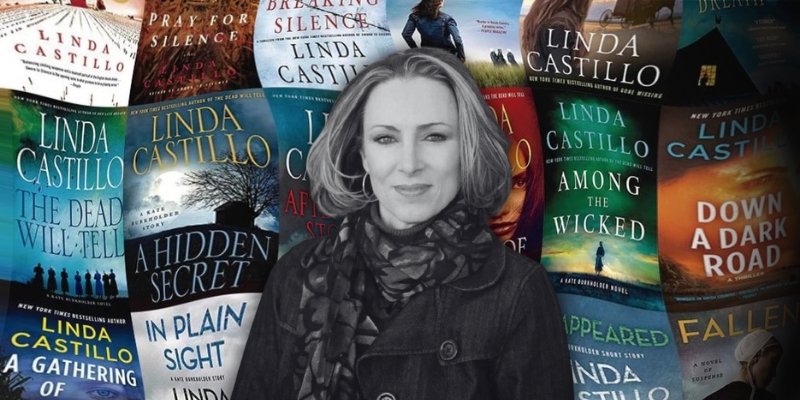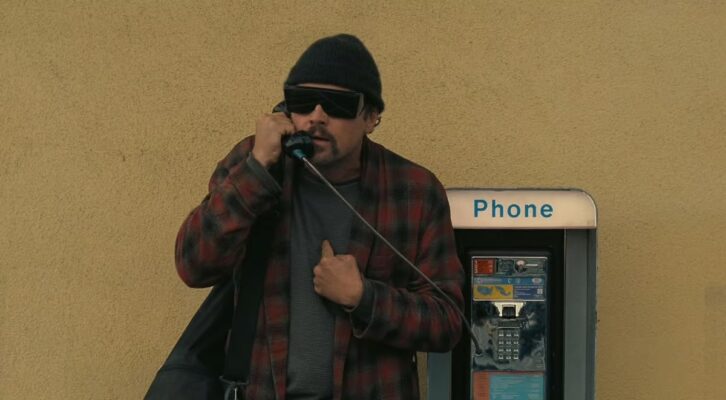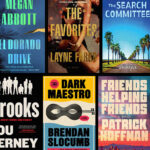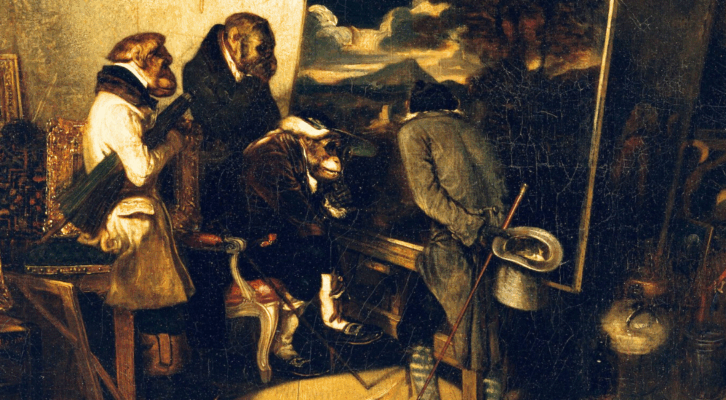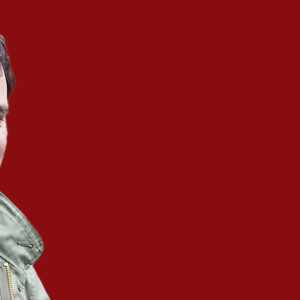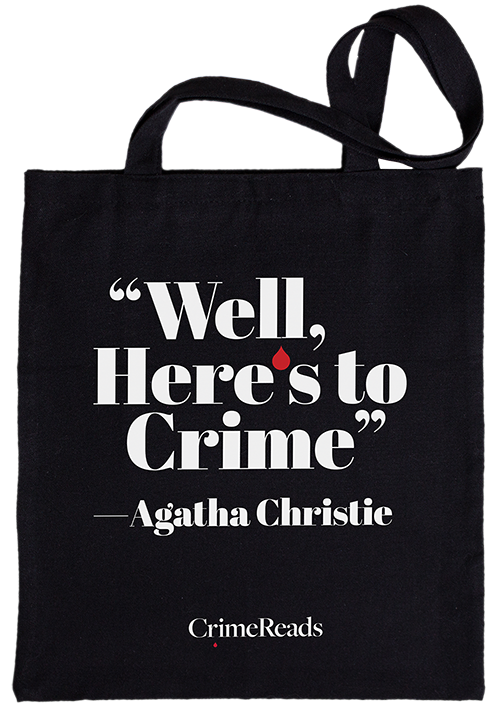Linda Castillo may know her heroine’s head and heart, but there’s still magic in discovery.
Sixteen years and seventeen books after introducing Kate Burkholder—Painter’s Mill, Ohio’s formerly Amish chief of police—in Sworn to Silence, Castillo is still learning the character’s flaws and foibles. It’s this heady mix of intimate knowledge and inspiring revelation that keeps her (and readers) engaged.
The books have become perennial bestsellers, having sold more than four million copies worldwide and been translated into fourteen languages. Castillo’s many accolades include The G.P. Putnam’s Sons Sue Grafton Memorial Award (for An Evil Heart) and an Edgar Award for Best Short Story (“Hallowed Ground“).
In the series’ newest entry, Rage (Minotaur Books; July 8, 2025), Kate—now married to John Tomasetti, an agent with the Ohio Bureau of Investigation—is tasked with solving the death of twenty-one-year-old landscaper Samuel Eicher, whose dismembered remains were discovered by a family of children playing hide-and-seek.
The disturbing nature of the crime leaves Kate understandably incensed—a feeling that is further amplified when Eicher’s best friend, Aaron Shetler, is also found dead, his body stuffed into a barrel and dumped in a ravine. Just what (or who) were they involved with to have met such violence?
With the town on edge, Kate must enter a world of darkness and depravity unlike any she’s ever known. As the investigation progresses, she begins to suspect that some of the community’s most vulnerable members—young people who’ve left their Amish upbringing for the freedoms of an unfettered world—may be involved.
But attempting to suss out the truth could also mean exposing them, and herself, to the evils that have risen up and threaten to destroy whatever innocence remains. To get justice for the dead and restore peace to Painter’s Mill, Kate must put it all on the line—including her very life.
Here, Linda Castillo reflects on the challenges and joys of keeping her books fresh, factually sound, and frighteningly real.
*
John B. Valero: Rage is your seventeenth full-length novel featuring Chief of Police Kate Burkholder. What have you found to be the key(s) to keeping the series fresh and maintaining high stakes despite its longevity?
Also, in general terms, tell us how this entry marks a progression of the overall story arc while also providing a singular experience for first time (or sporadic) readers.
Linda Castillo: It’s hard to believe Rage is the seventeenth book in the series! (That seriously freaks me out a little. LOL!) Keeping a long running series fresh is a huge challenge—and vital to keeping readers engaged.
One of the best ways to do that is through character growth. I love writing Kate Burkholder, the formerly Amish chief of police. She’s driven and flawed and human, a combination of traits (along with her background) that makes her so interesting.
Kate has come a very long way since the damaged and troubled character we were introduced to in the first book, Sworn to Silence. Over the course of the series, I’ve learned about what makes her tick. I know what’s in her heart, in her head; I know what she loves, what she hates. I know her weaknesses and strengths. I know what motivates her and I know what terrifies her.
Kate has come a very long way since the damaged and troubled character we were introduced to in the first book, Sworn to Silence.It’s my job to reveal those individualities to the reader, one layer at a time and in a way that’s integral to the story. By the same token, I can assure you there are things I don’t know about Kate. There are things to be learned about Tomasetti, too. When those previously undiscovered quirks or flaws or emotions pour onto the page during the writing process, it’s magic.
With regard to your question about how Rage fits into the overall story arc: Each book in the series can be read as a standalone mystery (though series purists will wholeheartedly disagree!) With each novel, I do my best to relay to the reader just enough background so that they are grounded and have a solid feel for time and place and the characters. The one thing I strive not to do is rehash old news to longtime readers.
JBV: Kate and agent John Tomasetti (the Ohio Bureau of Criminal Investigation) are relative newlyweds. How does the personal nature of their relationship influence their professional lives, both in terms of their own emotionality and the awareness of others’ perceptions in regard to potential conflict/lack of objectivity?
LC: I began my career in the romance genre. Those years taught me a ton about developing character relationships, adding the depth and conflict and flaws. That experience has helped me tremendously, particularly when it comes to the relationship between Kate and Tomasetti.
The series contains a strong police procedural aspect as well and it’s vital to keep it realistic and credible. That means there are certain situations when personal involvement in a case is not appropriate and I must work around that.
On another level, when a dangerous situation arises and the characters involved are involved in a serious relationship, the stakes are raised tremendously and that makes for great suspense.
JBV: You don’t shy away from showing the physical and emotional consequences of violent crime in your books—as evidenced by the very disturbing deaths in Rage (which include a postmortem dismemberment).
How do you endeavor to balance realism with respectfulness to achieve entertainment without exploitation? In what ways do we see Kate carry the weight of this burden throughout her investigation and private moments?
LC: The Kate Burkholder series is not for the faint of heart. Rage took me into some dark corners. Some of the research was unsettling to say the least.
While there are several gruesome and disturbing scenes, I feel those passages were necessary to drive home the nature of the underworld that’s encroaching on Kate’s domain. It’s her human response to those brutalities that wards off any sense of gratuitousness. We feel her pain and outrage. We are hurt and outraged, too.
Because of the violence on display, we know exactly what our villain is capable of. That raises the stakes. We know what could happen if he isn’t stopped. Therefore, we give Kate permission to pull out all the stops. Find the son of a bitch responsible. And bring them to justice.
JBV: In this book, you explore what happens when teens/young adults choose to leave the shelter of the Amish community into which they were born. Tell us about the resultant culture shock. How can this newfound freedom render individuals particularly vulnerable to the indulgences and threats of the outside world?
LC: For those of us who grew up amidst American pop culture, it’s difficult to comprehend the existence of young people who are profoundly inexperienced and/or naïve. One of the fundamental tenets of the Amish is separation from the rest of the world. Amish parents—and the community as a whole—strive to remain separate.
Are all Amish children sheltered from the rest of the world in exactly the same way? No. Like any culture, the way kids are raised depends on their parents; some Amish kids see and hear more than others.
As a writer, I was intrigued by the contrast between Amish and English youth. I was intrigued by the idea of a naïve young person getting caught up in a world he or she is ill-equipped to handle. That naivety and/or lack of life experience could render them vulnerable to those who would do them harm. Rage drives home the risks and some of the things that could go wrong.
JBV: The Amish are loath to speak ill of the dead. In what ways can their tenets of conduct frustrate, or mislead, an investigation—and how does Kate’s role (as ex-Amish) within the community both help and hinder her abilities as an officer of the law?
LC: Kate has great respect for the Amish. As I mentioned earlier, one of the fundamental tenets of the culture is to remain separate from the rest of the world and adhere to the traditional values set forth by the Ordung which is basically the unwritten rules set forth by each individual church district.
When there is a crime that involves the Amish—whether said Amish person is a victim, suspect, or somewhere in between—Kate has her work cut out for her. There is a divide between the Amish and English and many times a lack of trust.
Sure, the Amish and English live in close proximity. They work together. They’re neighbors. Friends even. But that divide is real and it can run deep. An Amish person doesn’t want to say anything damning about one of his brethren—especially to a non-Amish person, but especially to a cop.
The biggest tool in Kate’s arsenal—and probably her biggest frustration—is her understanding of the culture. She grew up Amish. She knows the traditions and speaks the language.
Though many times the Amish won’t speak openly to her, Kate’s familiarity with the culture, and her being cognizant of the divide, helps open lines of communication that might otherwise remain closed. The thing that sometimes hinders Kate is that some Amish may be even more standoffish—or hostile—to her because she left the fold.
JBV: While the majority of the narrative is told through Kate’s first-person perspective, you also intersperse the occasional third-person POV to reveal character and circumstance. How does the intimacy of one play off the distance, or detachment, of the other. In what ways does this structure strengthen the story (or amplify its tension)?
LC: I love the first person, present tense perspective. It’s intimate and close and immediate—and it never lies. The reader experiences the story through Kate’s eyes and senses and heart. Sometimes the reader experiences a scene through the eyes of the victim.
There’s intensity in that, I think, which I like. As a writer, I feel that certain stories or characters or scenes demand a more distant POV. All in all, I try to tell the story in a way that gives the reader the richest and most enjoyable story experience.
JBV: Like Kate, you are from Ohio’s farm country—though you are not Amish. How have you endeavored to capture the Amish lifestyle with authenticity and nuance—and what advice would you offer to others seeking to inhabit circumstances other than their own for the purposes of storytelling?
LC: I grew up in a small farming community in Ohio and that has been tremendously helpful. Not necessarily with depicting the Amish culture, but in portraying the rural lifestyle. (Yes, I know my way around a pitchfork!)
When I began the series, I knew very little about the Amish. But the story I had in my head needed to be told and I basically became obsessed with learning.
Did I make mistakes? Of course, I did. Information about the Amish culture wasn’t always easy to find. So much of it is lived and passed down from generation to generation, and not discussed or written down. There are several good books that helped me and I took full advantage.
It wasn’t until I began meeting people from Amish country, both Amish and non-Amish, that I really developed an in-depth understanding. As a result of those interactions—and friendships—I learned. Like Kate, I have a lot of respect for the Amish, their traditional ways, and that they’ve been so successful in maintaining their way of life here in the U.S. for almost three centuries.
For authors looking to write about another culture, I would have to say immerse yourself in that culture as much as possible. Read everything you can get your hands on. Spend time with the people you want to write about. Hang out. Ask questions. Make friends and enjoy them.
JBV: Your debut novel, Sworn to Silence, was adapted for television as An Amish Murder starring Neve Campbell. What was it like to see your vision brought to life in this manner—and do you think the reading and viewing experiences enhance one another or should be experienced separately?
LC: It was incredibly exciting to see Sworn to Silence brought to life. Neve Campbell was perfectly cast as Kate Burkholder. One of the elements I thought was done particularly well was the depiction of a small town in Ohio’s Amish country. The cinematography was beautiful.
Lifetime “softened” the tone of the book (Sworn to Silence was a far cry from a cozy mystery!) but I think it was a good call for their audience and it worked.
JBV: In addition to writing, one of your other great passions in life is horses. What draws you to equestrian pursuits – and how do these activities serve as both a catalyst to the creative process and a counterbalance to the rigors of writing (which is often solitary and sedentary)?
LC: I’ve always been a workaholic and I’ve always been driven and passionate about writing. Those things have served me well. But as is usually the case in life, too much of a good thing may not always be a good thing. Years ago, I was looking at burnout and needed something else in my life. I’d grown up with horses and have always loved them.
In 2004, I took a big chance (against my husband’s wishes!) and (with my troublemaking female friends egging me on!) I bought an appaloosa gelding. He was a little rough around the edges and dirt cheap. But I loved him. I spent the next year relearning everything I thought I knew about horses.
For authors looking to write about another culture, I would have to say immerse yourself in that culture as much as possible.George (my gelding) and I spent a lot of time together that first year (the good, the bad and the ugly!) and became best friends. I rode every day and I loved every minute. That first year with him will always be one of the most special times of my life.
JBV: Leave us with a teaser: What comes next?
LC: Oh that’s such a great question. 😊 I recently completed my twelfth Kate Burkholder short mystery. My publisher is going to publish a collection of the shorts that have never before been in print. The title is A Dark Path and will be released in spring of 2026.
Currently, I’m working on the next Kate Burkholder mystery. I’m still finding my way, but this story has great fire and Kate once again has her hands full to say the least.
***

